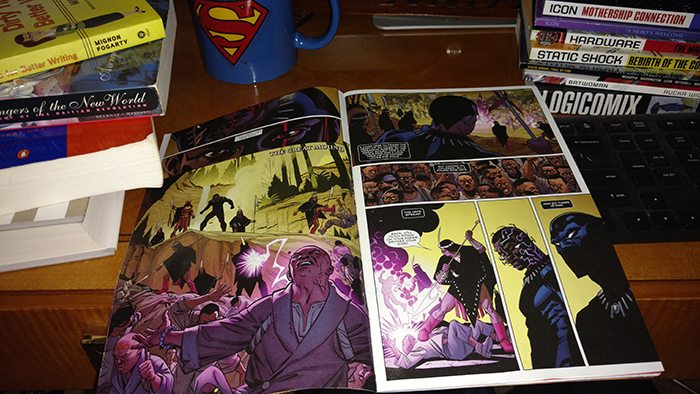
I’m enjoying a refreshed appreciation for printed books as a whole. After a few years of reading electronic books almost exclusively, the luxury of quiet paper bound for a single purpose feels very real. I relish still moments with hardcovers in particular.
That said, I’ve mostly phased out the long-loved type of book that led to my long term relationships with sex criminals, new gods, mutants, and superheroes: new single issue printed comic books.
As much as I enjoy visiting comic book shops, I don’t have the time to regularly do so. And depending on the day, I might be far away from inviting community spots like Philly’s Amalgam Comics and Coffeehouse. It’s much easier for me to get my Wednesday fix digitally; I open an app and motherbox provides. That digital has made comics accessible to people without a local shop may be one of the reasons digital comics have thus far complemented rather than replaced print comics in the wider market. Digital brings in new and distant customers while the shops Mark Waid described as “pop culture oases” continue to sell products to both collectors, who need everything bagged and boarded, and regulars who have a sense of which books work better in print (comics theorist Scott McCloud discusses that here).
Convenience is a consideration, but storage is more significant.
While the shelves of books I maintain across my home make me feel like I live in a sacred space (think Machiavelli visiting “the antique courts of the ancients”), I accept the exchange of single issue floppies for empty space and art. Portability and the volume of stories I consume made this change practical. I like to reread, but longboxes don’t sanctify like shelves.
But beyond the floppies of Wednesday, there are graphic novels and collected editions. In those forms, comics can deliver the tactile and aesthetic experiences to score shelf space. Engage my senses with the right look, textures, and weight. Look pretty wherever housed. Artfully display notes in margins or wherever appropriate to tell me more about inspirations, references, and what I might find interesting about how what I’m holding came to be.
Wakandan kings and Amazon warriors don’t appear anywhere in it, but after reading and touching my way through A Communicator’s Guide to The Neuro Science of Touch, I wondered what the future Ms. Marvels, Princelesses, Statics, Supermen, and Atomic Robos might feel like. A project of Sappi, written in collaboration with neuroscientist Dr. David Eagleman, the guide is a layperson’s introduction to haptics, the science of touch. Appropriately, the book communicates through words, images, colors, textures, folds, and supporting content available via the Layar mobile app.
Haptics must partially explain why I’m moved to say words like “sacred” and “sanctify” when I think of how books fit into my world as physical objects. Add this science to the comics toolkit that print and paper experts can help keep modern and fresh. Since 2011, I’ve transitioned away from floppies, but I don’t live by digital alone. Flush with the fantastic, comics remain well-suited for innovations in storytelling through the sensuousness of paper.
Andy Solages connects people and organizations with technologies to improve professional experiences and business results. Andy is a monthly contributor to Print Media Centr’s News from The Printerverse and a regular participant in #PrintChat on Twitter.
Treat yourself to more Andy: Twitter | LinkedIn | andysolages.com











One Response